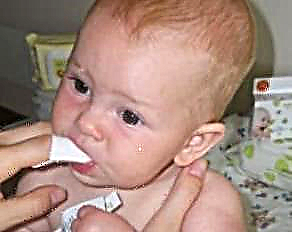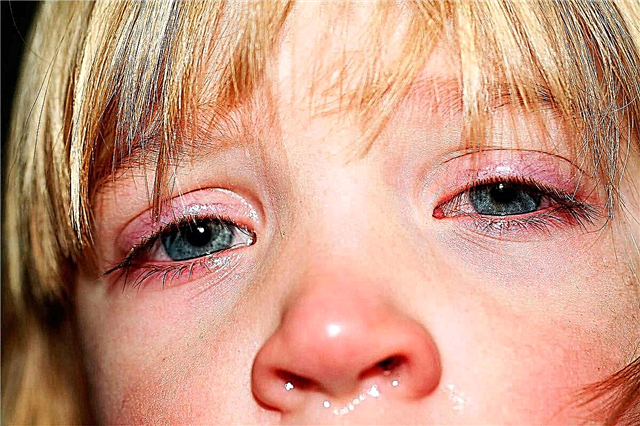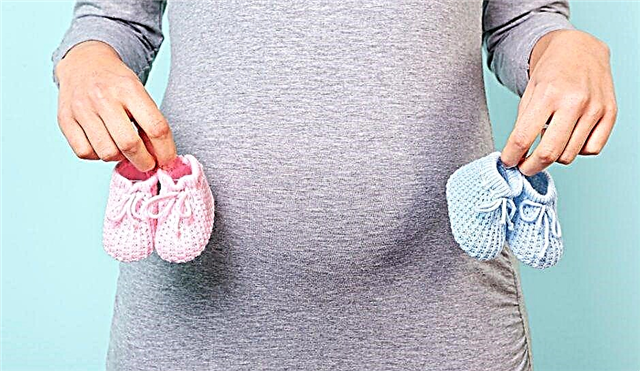
Breastfeeding mothers are more sensitive and attentive to their diet, because what a woman eats, partly with breast milk, comes to the child. The baby's digestive system is very fragile, imperfect, and many foods that adults like can harm him. Therefore, the question of eating fish during lactation is one of the most frequent.

Benefit and harm
Popular rumor warns new mothers against eating fish. It is believed that neither river nor sea fish is desirable during lactation, especially in the first 1-2 months after birth. In fact, this is a myth, according to nutritionists and pediatricians.

A small amount of properly cooked lean fish will benefit everyone - both the mom, who needs to recover from childbirth, and the baby, who many substances contained in fish are needed for harmonious growth and development.
- The main advantage of fish is Omega-3 polyunsaturated fatty acids. There is nowhere else to take them, except for fish, and the benefits of them are obvious. Omega-3 acids contribute to the normalization of the cardiovascular system, actively participate in metabolic processes, and also have a calming effect on the nervous system, which is very useful for a nursing mother.
- Large amount of B vitamins beneficial for both participants in breastfeeding, because these vitamins are directly involved in metabolism at the cellular level, and also regulate the activity of the nervous system.
- Protein as a part of fish fillets it is very easy to digest, does not burden the digestive system. At the same time, it is important not only for a growing child who will receive it with mother's milk, but also for the woman herself, since easily digestible proteins are involved in the process of normalizing kidney function (after childbirth, there is an intensive restructuring of their functioning).
- Fish, especially sea fish, are very rich vitamin D, which is involved in the absorption of calcium. Eating fish twice a week will allow mom to improve the work of her own intestines. This will definitely not harm the child.
Fish will diversify the menu of a nursing woman, which is fully consistent with one of the main principles of breastfeeding - variety and safety.
However, you need to understand that there are varieties of fish that are too fat, which can negatively affect the composition of breast milk - it will become fatty and it will be more difficult for the child's body to absorb.
There are also exotic fish varieties that can cause allergies in both the mother and the child. Fish absorbs many harmful substances that enter the water, and therefore a fish caught in ecologically dirty regions or in areas of industrial accidents can be rich not only in Omega-3, but also in radioactive substances, oil products.
How to choose?
Fish for a baby's mother must meet a number of important requirements.
- It must be fresh, not expired, of high quality. You should not buy it from unknown sellers, in the markets, near the roads - such products are usually not certified, and no one can guarantee their safety.
- It is best to take fish that is geographically specific to a particular region in which the family lives. Exotic warm-water marine varieties, unusual for the North or the Far East, are unlikely to benefit.
It is important that the fish is lean. For the first month after giving birth, varieties such as pollock, carp and herring are perfect.
- The fillet should have a thin ice glaze if frozen, and the whole carcass must have intact fins and intact scales. The smell should be moderate. A strong odor or an unnatural color is a danger signal, as are cloudy fish eyes.

What fish can you eat
A woman is allowed to introduce fish into her diet within 15-21 days after giving birth. But it must be remembered that sea fish is more allergenic than river fish, and therefore, for a start, when breastfeeding a newborn and for the entire first month, it is advisable to eat the inhabitants of the rivers. In the second month, the menu can be diversified with low-fat varieties of sea fish.
In the first month, you can cook and eat soups with fish broth. At first, it is advisable to cook the fish in two waters. The primary broth is drained, and soup is made from the secondary. Boiled fish can be eaten whole, steamed or baked with vegetables, and stewed fish is also allowed with HS.

Among all river fish, it is best to give preference to perch, which contains relatively few bones and calories, bream, which is rich in chlorine and potassium, river trout, burbot, pike and pike perch.
It is clear that sea fish is more pleasant to cook and eat, since it contains fewer bones, and also you can cut a beautiful fillet from it. At the end of the first month, you can carefully begin to introduce into the diet and the inhabitants of the sea. But you need to do this from small portions, literally from a piece of fish.
If in a day the child does not develop an allergic reaction, digestion, stool, and the product can be injected. All varieties that can be attributed to the so-called red fish - pink salmon, chum salmon - are especially carefully introduced. Salmon is a fish that is recommended to be tasted in very small portions, as it most often causes allergic reactions in infants. Saltwater fish are also steamed, boiled, baked and stewed.
When breastfeeding, it is quite possible to afford the following saltwater fish:
- salmon (rich in selenium, iodine and useful protein);
- sea bass (does not contain a large amount of fat, but is a real leader in the amount of vitamin B12);
- hake (rich in vitamin A, low in calories per 100 grams of product);
- pollock (rich in potassium and calcium, almost no fat, low in calories);
- sardine (rich in magnesium, selenium and zinc).
These varieties are convenient because a woman can introduce them into her menu without fear of gaining weight. These are dietary varieties of fish, if they are also properly cooked, the benefits will be undeniable.
What is better to abstain from?
With all the visible benefits of a nursing woman, you should know that uncontrolled and improper use of fish during lactation may well harm both the baby and the mother's body.
Any fish that was stored improperly, was frozen and thawed several times (which will be clear from the state of the scales and dull eyes), increases the likelihood of not only food poisoning, but also infection with dangerous parasites, which choose fish as an intermediary, but are just waiting to get into the human intestine.
- White fishsuitable for introduction into the diet within the established time frames described above, can not be served fried or dried. River fish, fried in a frying pan with a crispy crust, is categorically unsuitable for a woman when feeding her baby with breast milk. When frying, healthy and light food turns into food that takes much longer and harder to digest.

- Dried and dried fish - too salty, which can lead to the accumulation of fluid in the body, to edema. If these requirements are ignored, the child may already have stool disturbances quite quickly - constipation will alternate with diarrhea, breast milk will have high fat content, which can negatively affect the state of the baby's stomach, pancreas and gallbladder.

- Smoked fish dangerous for three reasons at once.
- It is salty, which again has a bad effect on the state of water-salt metabolism and can cause edema.
- When smoked, it is not subjected to total heat treatment and may well be inhabited by parasite eggs (especially when it comes to river fish).
- Smoked fish is often treated with chemical smoke, which contains carcinogenic substances. They perfectly penetrate into milk and are passed on to the child, increasing the likelihood of serious consequences for his health, including cancer. And this is the most compelling reason to abandon smoked fish with HB.

- Salty fish also undesirable due to the presence of salt and spices and the lack of heat treatment. This also applies to lightly salted fish.
- When breastfeeding your baby also you should refuse canned fishas they are rich in sugar and preservatives. Such a composition affects the quality of breast milk, into which up to 75% of all preservative substances enter without obstacles.
- Should give up all fatty fish, even boiling and steaming mackerel and herring is strongly discouraged.


It is undesirable to eat fish dishes more than twice a week, because even healthy iodine can cause an overdose if consumed in excess. Two meals of fish are enough for a woman to fill her weekly need for Omega-3, as well as selenium, iodine and magnesium.
Recipes
The proposed recipes will help facilitate the task of a nursing mother, which will allow you to cook a fish dish so that there is benefit, but no harm. Many of them have been tested by more than one generation of mothers with babies, and therefore it is safe to say that they fully comply with the rules of medical nutrition.
Steam pollock for the second
It doesn't take long to prepare such a simple dish. Cut the pollock carcass, previously peeled and washed, into pieces, add a little onion and salt (do not oversalt the dish, this may cause kidney problems). You can also use pollock fillets.
Place the pieces in a steamer or multicooker in steamer mode and cook for 25 minutes. You can eat with a side dish of buckwheat, mashed potatoes or vegetable stew.

Oven-baked carp
Baked river fish will be an excellent dinner option not only for a nursing mother, but also for the whole family. For cooking, you need a large carp, a small carrot, an onion, 10 grams of butter. Grate the carrots, cut the onion into thin half rings. Place the vegetables in a baking dish and brush with a lump of butter.
After cleaning and washing, the fish should be lightly salted. If you plan to eat the dish a woman breastfeeding, avoid using spices for fish. The whole carp is placed on top of the vegetables, a little water is added to stew the vegetables. The mold is placed in an oven preheated to 200 degrees. You need to bake for about 45 minutes.

Pike or pollock cutlets
You can cook them in different ways - steamed, stewed or baked in the oven. Regardless of the method, you will need fish fillets, an egg, salt, a little semolina. After scrolling the fillet in a meat grinder, all the ingredients are mixed and in order that the minced meat does not turn out to be too liquid, add a little semolina.
Cutlets are formed and cook without preliminary frying in the chosen way: in the oven - at least 35 minutes, in a double boiler - at least 25 minutes, in a small saucepan with half a glass of water or fish broth, stew cutlets for at least 30 minutes. Serve with mashed potatoes or any other permitted side dish.

Fish in sour cream sauce
For the dish, both river varieties and sea fish, for example, hake or pollock, can be used. Cut the fish into portions, salt and place in a small container. Simmer for about half an hour over low heat with a little onions, a spoonful of olive oil and half a glass of water.
10 minutes before cooking, add a few tablespoons of sour cream, mix gently and keep covered for another 10 minutes.

Fish with apples
To prepare such a dish, it is best to take sea fish, the aroma of which will be favorably complemented by apples. For one carcass of pollock, you will need an onion and two green apples.
Apples are washed, peeled, cut into small slices. The fish, washed and peeled, is added to a bowl with apple slices, put onions, salted and kept for half an hour until it gives juice. First put apples and onions into the mold, and fish pieces on top. Bake in the oven for at least 45 minutes.

Fish casserole
Cut the fish fillet into small pieces and leave in the marinade of one grated green apple for half an hour. You can immediately salt the fish. Then the fish pieces are mixed with finely chopped onion, grated carrots and laid out in a mold. Bake in the oven for about 40 minutes.
Then the cooked sauce is poured into the mold - sour cream, water and a little dill. With the sauce, the casserole is kept in the oven for another 15 minutes. You can eat the casserole both cold and hot, with a side dish or as an independent dish.

We also suggest taking note of a simple and quick recipe for fish soufflé from the following video.
General recommendations
Before adding fish to the diet for HB, it is important to clarify several important nuances:
- whether the woman has ever had an allergy to fish and seafood;
- whether the child's father has such an allergy to fish and other seafood.
The fact is that some types of allergies, including food allergies, are inherited from their parents. And even if a woman eats fish with pleasure and does not have negative immune reactions to this product, there is no guarantee that the child will not develop an allergy borrowed from the dad at the genetic level.
Before adding fish dishes to the menu, a nursing mother should definitely ask the pediatrician who observes the child about such an opportunity.




